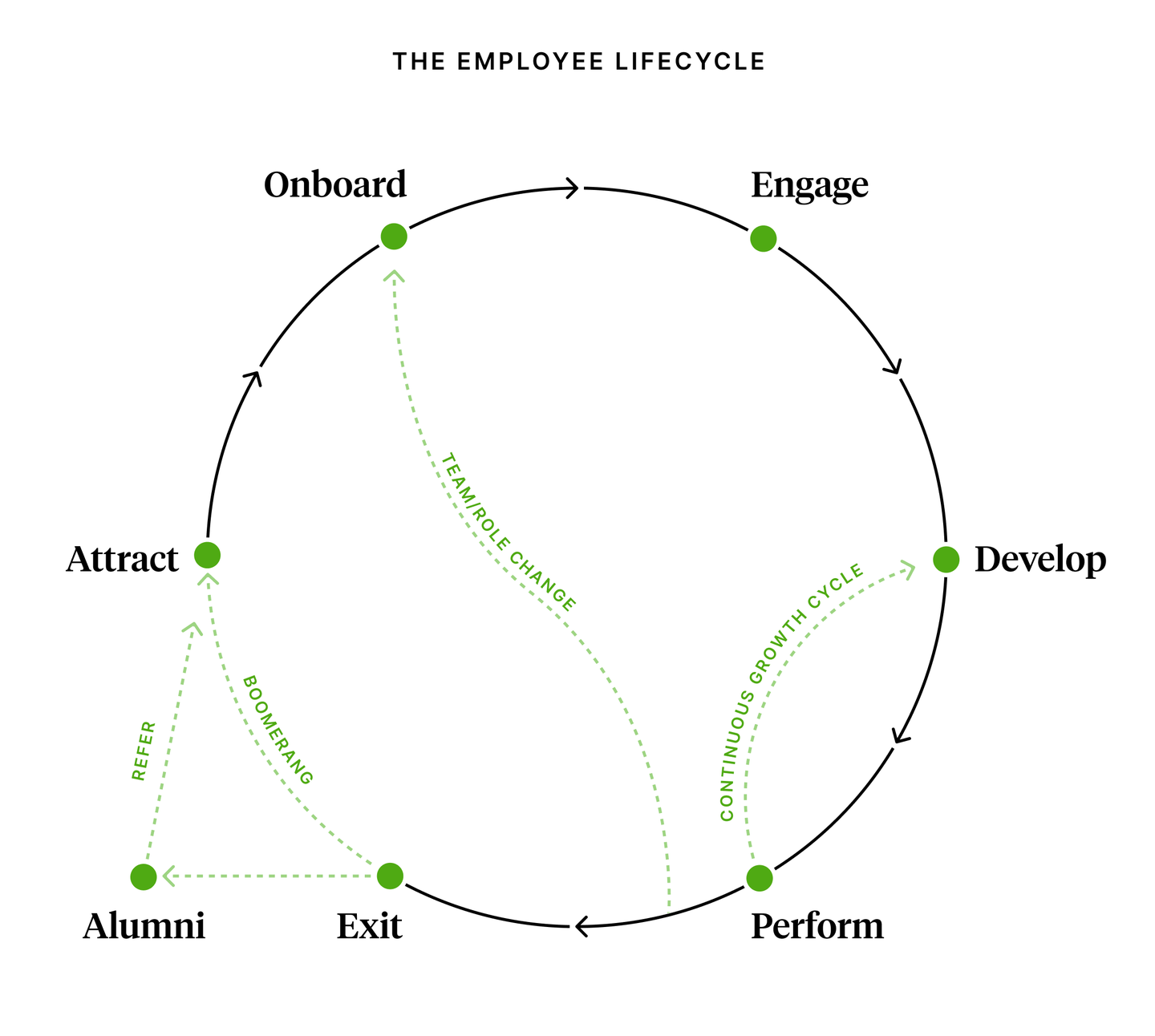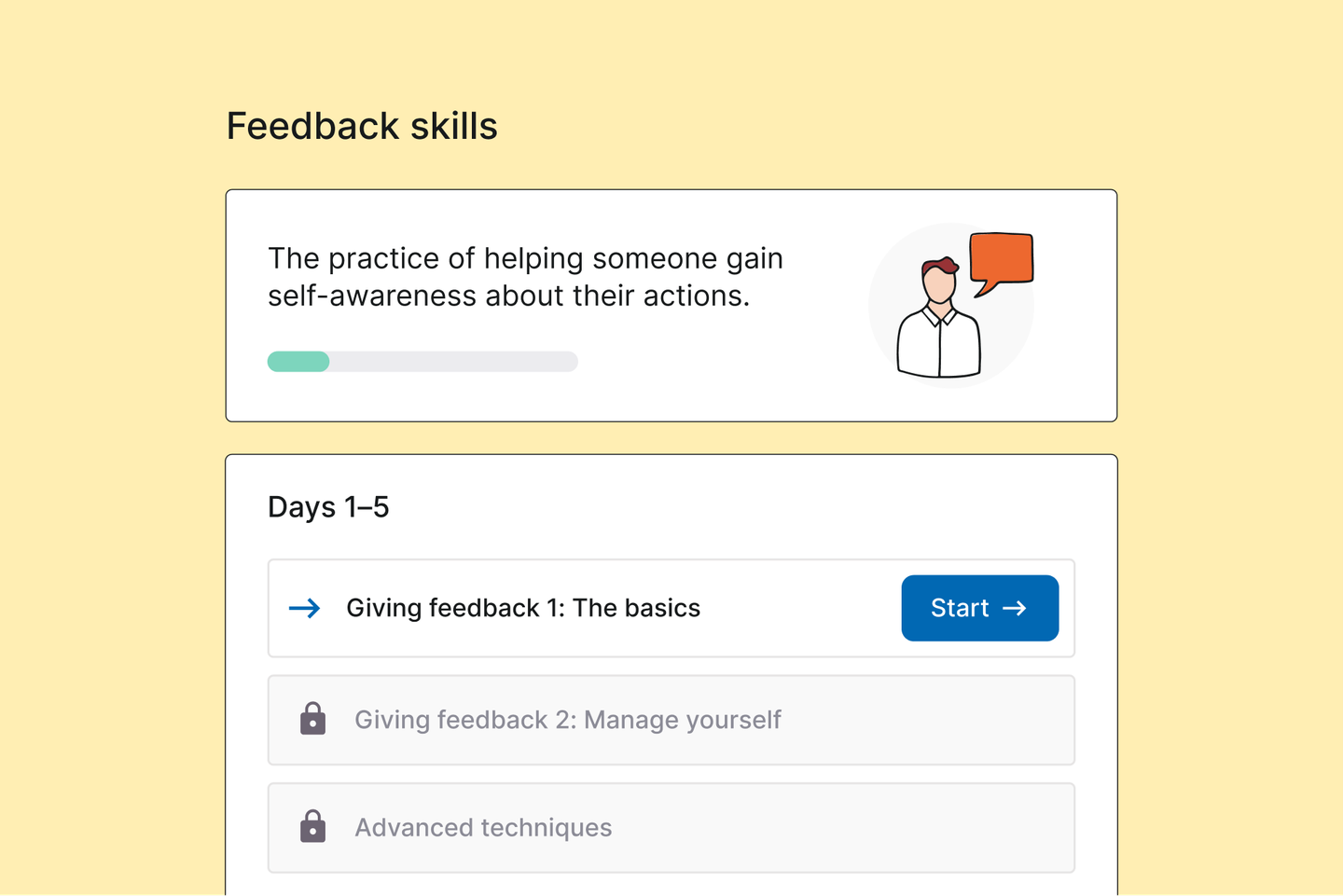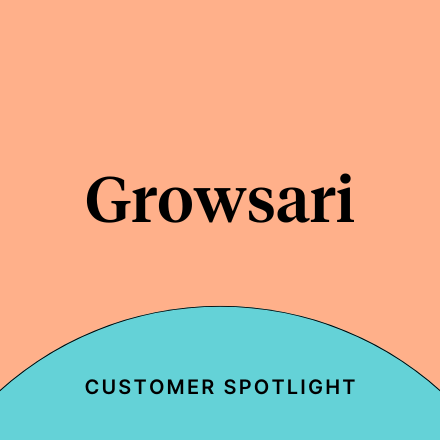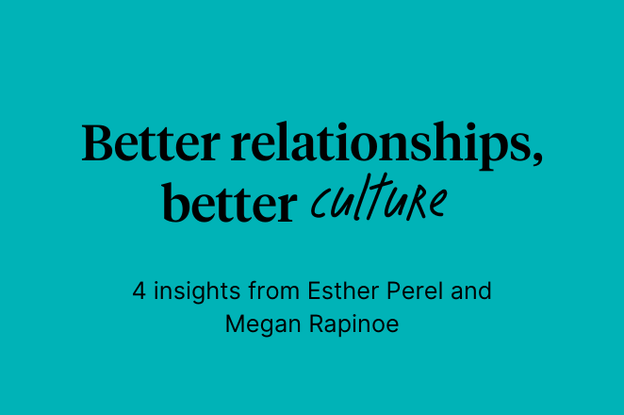HR’s complete guide to employee experience

contents
From an employee’s first day at your company to their last, every interaction they have with your company shapes their overall employee experience. A poor employee experience can leave an individual feeling disconnected and unmotivated, while a strong one can boost employee productivity, loyalty, and engagement.
As an employer, it’s your job to understand what your employees want from their employment with you and craft an employee experience that meets or exceeds their expectations. To do this successfully, you need to listen to your talent and take action to prioritize their needs. Ultimately, their experience – whether it’s positive or negative – will impact the way they show up for your business, so employee experience is one of the most important investments your business can make.
In this guide, we’ll take a closer look at what employee experience is, why it’s important, how to measure it, and best practices for making it a top priority for your organization. You’ll learn how to improve the employee experience at your company and set your business apart as a top employer in the process.
What is employee experience?
Employee experience (EX) encapsulates what people encounter and observe throughout their tenure at an organization. It spans from an employee’s first day at your company to their last – including all the different touchpoints in between that make up the employee lifecycle.
The employee lifecycle is made up of seven unique stages.

- Attract - Candidates learn about your company and the role and decide if it’s the right fit for them. During this stage, people may become advocates for your organization, regardless of whether they join it.
- Onboard - Employees get the training and knowledge they need to settle into their roles. The stage is critical because the effectiveness of your onboarding program can significantly impact the employee’s tenure.
- Engage - Employees learn more about your company and what it stands for, leading them to greater motivation, commitment, and connection.
- Develop - Employees receive feedback on how they’re doing and the tools and skills they need to grow. They may receive stretch assignments or other development opportunities to grow in or out of their role.
- Perform - Employees are evaluated on their performance and recognized for their achievements. How your company approaches performance reviews and compensation significantly shapes your employees' experience during this stage.
- Exit - Employees depart your organization and begin their next chapter. During this stage, administering an exit survey may help you understand why an employee decided to leave your company.
- Alumni - If the employee experience is positive, employees continue to cheer on the company from the sidelines.
The employee experience is shaped by how your organization approaches each and every one of these steps.
What factors shape the employee experience?
Of course, salary, benefits, and company culture play a major role in shaping the employee experience, but they’re only the tip of the EX iceberg. The employee experience is impacted by everything employees encounter, including your business’s commitment to fair hiring and promotion practices, its relationship with the local community, and even your managers’ likelihood of checking in with their teams daily.
Here are other examples of factors that influence the employee experience:
- A culture of recognition
- Diversity, equity, and inclusion (DEI)
- Employee autonomy
- Employee development
- Healthcare and voluntary benefits
- Manager relations
- Mission, vision, and values
- Office space
- Organizational transparency
- Performance management practices
- Work-life balance
- Workplace policies
Why is employee experience important?
Exceptional employee experience can measurably boost engagement, productivity, profitability, and reduce turnover – allowing your business to achieve success more efficiently and effectively.
One global survey found that nearly 80 percent of executives rate employee experience as very important or important. An analysis of over 250 global organizations backs this up. It found companies that scored highest on employee experience benchmarks experienced:
Statistics
4xHigher average profits
2xHigher average revenues
40%Lower turnover
… compared to those that didn’t.
Below, we share just a few reasons your C-suite probably has employee experience top-of-mind, too.
Higher engagement
Employee engagement is the measure of the relationship between employees and an organization. It’s one of the constellations of feelings that can result from the employee experience. Most companies measure and aim to improve their employee engagement since it’s highly correlated with turnover and how much effort their people are likely to put into their work. It’s one of many possible results of a good employee experience.
Building an exceptional employee experience can increase employee engagement. When your employees find value in the work they do, feel recognized and rewarded for their contributions, and are aligned with your company mission and values, they are more likely to put in their best effort, stay loyal, and speak positively of your organization to colleagues, friends, and customers – even after they exit your organization.
More successful recruiting
Today, most job seekers look for information about a company on job search websites like Glassdoor. The rise in company review sites like Glassdoor indicates the desire of employees to understand what their experience will be like at an organization. It only takes a few negative reviews to chase away potential talent for your organization, so it's important to do everything you can to craft a positive and engaging employee experience.
Increased productivity
It’s no secret that happy employees are more productive and efficient employees. To confirm this, Culture Amp partnered with customer service software company Zendesk to see if companies with higher engagement scores had higher customer satisfaction scores.
By combining Zendesk’s customer satisfaction and support ticket data with Culture Amp’s employee engagement benchmark data, we discovered that companies with engagement scores above our benchmark scored 10% higher on customer satisfaction than companies below the benchmark.
These higher-scoring companies also had lower first response time but higher first resolution time, meaning they could tackle incoming tickets quickly while taking the time and care to ensure a customer’s issue was completely resolved before closing a ticket. Unsurprisingly, businesses that create a better employee experience benefit from higher engagement and productivity.

Overcome uncertainty by putting culture first
Get the latest research on how the employee experience affects an organization’s ability to navigate change, and understand how retention shapes your workforce.
Reduced turnover
Our research shows that around 10% of people leave a new job within just six months. That turnover can often be attributed to a poor employee experience and proves why investing in the employee experience from your employees’ first day to their last is so important. For example, a proper onboarding experience can make a huge difference with regard to an employee’s future desire to stay, their productivity, and their perception of the company culture.
At Culture Amp, we’ve found most employee departures can be tied to one (or more) of these three factors: career growth, role expectations, and inclusion. You can easily measure and track changes in employee sentiment around these three key areas by asking these three questions in your employee engagement surveys:
- I believe there are good career opportunities for me here at [Company].
- I am happy with my current role relative to what was described to me.
- I feel like I belong at [Company].
Carefully monitoring shifts in team, department, and company-wide morale vis-à-vis these questions can be a key indicator that your business needs to invest in these areas of the employee experience.
Increased profitability
According to a study by MIT's Center for Information Systems Research, organizations scoring in the top quartile of employee experiences achieve twice the customer satisfaction and innovation, and generate 25% higher profits than those that scored in the bottom quartile.

How to measure employee experience
At Culture Amp, we believe the best way to measure employee experience is by conducting employee surveys throughout the employee lifecycle. For example:
- Attract stage: Candidate experience survey
- Onboard stage: Onboarding survey, 90-day stay interviews
- Engage, Develop, Perform stages: Engagement surveys (annual and pulse)
- Exit stage: Employee exit surveys
Such surveys provide important, objective, quantitative data you can use to understand where your employee experience excels and where it falls short. Moreover, by collecting data over time, you can see how that experience changes over time, including whether your initiatives are making a meaningful difference.
Depending on the survey and the questions you ask, you can better understand various aspects of the employee experience, such as availability of resources, clarity around goals, perception of leadership, etc.
How favorably or unfavorably employees respond to such questions can reveal insightful trends relating to your employee experience. For example, if you notice favorability around performance-related questions nosediving after implementing a new performance review process, it may indicate the need for greater enablement or education. Or, you may notice that after making BIPOC representation in leadership a priority, scores around belonging and leadership rise.
TIP: Employee experience varies by individual and is shaped by one’s identity.
The employee experience isn’t equitably experienced, which is why we highly recommend collecting demographic information about your employees. This information enables you to slice and dice your data in a way that lets you identify disparities within the employee experience for different segments of your workforce. For example, BIPOC vs. non-BIPOC, full-time vs. part-time, remote vs. in-office vs. hybrid, or disabled vs. non-disabled.
What KPIs should you use to measure the employee experience?
While measuring employee experience, it’s important to have a key performance indicator (KPI). At Culture Amp, the main KPI we use is employee engagement.
We consider engagement a holistic measurement of the enthusiasm and connection an employee feels towards your organization as a result of their experience at your organization. At a high level, engagement covers:
- Pride. “I am proud to work for [Company]”
- Recommendation. “I would recommend [Company] as a great place to work”
- Motivation. “[Company] motivates me to go beyond what I would in a similar role elsewhere”
- Present commitment. “I rarely think about looking for a job at another company”
- Future commitment. “I see myself still working at [Company] in two years’ time”
It’s important here to clarify the relationship between employee engagement and employee experience. Although employee experience directly influences what employees feel, it’s not the employees’ feelings – it’s what happens to them. Meanwhile, employee engagement is one of the feelings that can result from the employee experience. Since employee engagement directly informs whether people are willing to invest (their time, energy, and intellect) in the organization, it is what most employers want to understand and predict.
Of course, you can use many other metrics to measure the success of your employee experience. Some of these can be measured with surveys, while others require you to crunch other types of employee data:
- Development plan participation rate
- Employee absenteeism rate
- Employee satisfaction
- Frequency of recognition
- Internal promotion rate
- Internal referral rate
- Manager approval rating
- Retention rate
- Revenue per employee
- Survey response rate
Developing a framework for your employee experience strategy
An employee experience strategy (also known as “employee experience management”) describes how an organization takes action on the above factors to influence employee sentiment across the employee lifecycle.
At Culture Amp, we believe that developing a truly effective employee experience strategy starts with understanding where to prioritize your efforts. As a first step, we recommend using journey mapping to audit the different touchpoints of your employee lifecycle. You can map the employee experience with a simple, four-step framework:
-
Identify the moments that matter most to your employees
Look stage by stage. For example, during the attraction stage, “receiving an offer letter” may be a particularly powerful “moment that matters” for people at your company. -
Connect the moments that matter to your unique organizational context
Ensure congruence between what your company stands for and what employees experience. You can do this by identifying the key values you want to emphasize in your moments that matter. For example, if transparency is a key value, how can you connect that to an employee’s first experience with a performance review? -
Consider the employee perspective
Who an employee is shapes how they view the organization. Consider the identities that could affect the EX at your company and which moments would matter most to such an employee. For example, remote employees may feel particularly strongly about meeting their team for the first time. -
Prioritize
Decide what stage of the employee lifecycle to focus on, and choose a moment you want to improve upon. Determine how you will define and measure success (i.e., which question will you track in your engagement survey or which KPI will you use to prove the success of your efforts?).
These four steps serve as an employee experience framework for your future strategy. After you’ve mapped out the moments that matter most in your organization, you can develop a strategy for deliberately tackling each of these moments.
-
![A guide to mapping your employee experience]()
Guide to mapping your employee experience
Learn how to prioritize and amplify the make-it-or-break-it moments for employees—by mapping the employee experience from start to finish.
How to improve employee experience
Every business has a unique employee experience. While Company A might need to optimize its hybrid onboarding strategy, Company B might be better off investing in professional development opportunities for its long-tenured staff.
What will drive the most success isn’t a few one-off ideas for improving the employee experience but a holistic and personalized strategy. Here are our best recommendations for getting started:
-
Determine your top priority.
First, you need to identify what aspect of the employee experience your organization should focus on. If you’re about to significantly increase hiring volumes, you may want to focus on the attraction/recruitment stage first and consider using a candidate survey to get feedback. Or if you’re seeing high turnover rates, putting your resources into understanding and improving an employee's exit experience may be your first step. There’s no right or wrong place to start – it depends on your organization’s priorities. -
Start capturing data.
Once you’ve determined your top priority, the most important thing is to start capturing feedback. Collecting enough data to draw linkages and tell stories about the employee experience takes time. That’s why we recommend not overwhelming yourself by tackling everything at once. Instead, focus on one aspect of the employee experience (such as onboarding), iterate, and grow your employee experience data capture program. -
Build in linkages.
To build a comprehensive understanding of the entire employee lifecycle, it’s essential to build linkages to and from other content and data. For example, if you have already run an engagement survey, that data may also help you inform which factors to focus on in your exit survey. Also, make sure your surveys are customized to your specific programs instead of using cookie-cutter questions that don’t address the root of the problem. -
Empower action.
Employee experience surveys give you a lot of valuable information. But there’s no point in having it if you don’t use it to take action. We recommend looking at the aggregate results to modify your organization-wide programs and detailed results. From there, you can identify whether particular hiring managers, departments, or teams need extra support and help them understand how they’re doing compared to the company overall. This will allow everyone to make small tweaks to improve employee experiences.
However, if you’re still stuck trying to figure out where to focus your efforts, here are a few best practices to guide you in building an exceptional employee experience:
1. Create a culture of continuous listening
Optimizing the employee experience isn’t a one-and-done task. It’s an ongoing process fueled by continuous listening. While there are many ways to listen to your employees, one of the most efficient and effective methods is conducting regular employee engagement surveys so you can understand and track how your employees’ needs evolve over time.
Here’s a brief example of continuous listening to show you what it looks like in practice:
After computer software non-profit Mozilla had to undergo a round of pandemic layoffs, the company’s HR team decided to run a pulse survey to check employee engagement. The results revealed employees were exhausted, frustrated, stressed, and (most curiously) less likely to believe Mozilla had career development opportunities for them.
While the COVID-19 pandemic was clearly an extreme event, this story still exemplifies how crucial listening to your employees is to gaining insight into their needs, pain points, and overall employee experience, especially during a crisis.
More customer stories:
- How Asana prioritized employee experience during the economic downturn in 2023
- How GroupM APAC treated change as a springboard
- How Meltwater APAC built a better employee experience with feedback
-
![]()
Ebook: Humanity at work
Build a human-centric employee experience to create a better world of work.
2. Take action on employee feedback
Collecting employee feedback is meaningless without action. If people go through the trouble of filling out a survey, but nothing in the organization changes, they’re likely to get what Didier Elzinga, CEO of Culture Amp, calls “lack-of-action fatigue.”
Didier explains, “If the survey brought about changes or communication, people will be much more inclined to welcome the chance to do another survey, even if the changes were not what that particular person wanted. If they can see that a change was made on the back of results of a survey, they will see the survey as a tool for change.”
In order for employees to always be forthcoming and open about their thoughts, you must show them their feedback matters by being transparent about how you’re using their feedback to build a better workplace. One easy quick-win? Clearly communicate and share survey data with your entire organization and your team’s plans to implement change within your organization.
To continue our Mozilla example from above, the company’s HR team knew employees were not optimistic about their careers with the company, so they got to work trying to help alleviate employees’ concerns.
To start, the team reframed annual performance reviews to focus on ongoing feedback, employee recognition, and coaching conversations centered around learning and growth. With more real-time feedback and coaching from managers, employees became more positive about their own growth and development at the company. Even this small change to performance reviews had a lasting effect on employee experience.
→ Not sure what area of the employee experience to start with? Download our Action framework toolkit for tips to identify the most impactful focus areas from your survey results and examples from companies facing the same issues.
3. Use employee personas
An employee persona is a profile of a specific employee segment that details their characteristics, attitudes, wants, and needs. HR teams can use these profiles to better tailor their initiatives to different segments of employees present in their workplace. For example, if you’re debating which new voluntary benefit to introduce, you’ll want to consider the makeup of your organization and the needs of your employees. A childcare stipend might not be a unanimously well-received benefit for a predominantly young workforce, but it might make more sense for a company with a workforce made up of caregivers.
While you’re probably already informally using personas as a part of your employee experience model, it’s a good idea to take the time to develop and document 3-5 personas for your workplace. That way, you and any new HR teammates that join your company can quickly and easily reference them every time you launch a new initiative to ensure you’ve considered it from the perspectives of different types of employees at your company.
4. Invest in managers
Managers directly impact an employee’s day-to-day experience at your company, so ensure that managers are properly equipped to support their direct reports. While in the past, businesses were focused on training managers in highly technical skills, recent years have shown that soft skills are equally important. Businesses need to train managers on giving good feedback, leading through change, acting with empathy, communicating asynchronously, and more – but meaningful change is rarely achieved from one-off training programs.
To support your managers in developing these skills, consider harnessing ongoing conversational microlearning with solutions such as Culture Amp’s Skills Coach tool. Using Skills Coach, managers receive daily bite-sized activities and learnings via Slack, Microsoft Teams, or email that they can seamlessly incorporate into their daily routines. Through the magic of spaced repetition, your employees can become better, more effective leaders.

These are just four employee experience-focused ideas to help inspire you to take action in your own workplace. Remember that the most effective and powerful way to improve the employee experience is to listen to your employees and prioritize your initiatives based on their feedback. By asking your employees what they want, you can implement meaningful changes that make an impact.
Additional resources
- Building an employee experience for a hybrid workforce
- How to build an employee experience with social impact
- 4 tips for creating an equitable employee experience
- Using employee experience data to conquer workplace politics
- 7 charts that define the employee experience in 2023
Start prioritizing your employee experience today
Your employee experience isn’t something you invest in once and never revisit. It’s dynamic, varies at every stage of the employee lifecycle, and needs constant attention and improvement. And to effectively monitor and track changes at every stage of an employee’s tenure, you need a robust employee experience management solution that can help you track engagement, performance, and development.
Luckily, Culture Amp’s complete employee experience solution has you covered, allowing you to empower your teams and fuel positive change in one intuitive platform. Improve talent retention, increase business performance, break down silos, and drive engagement at every step in the employee lifecycle with engagement, development, and performance tools made for today’s world of work.










